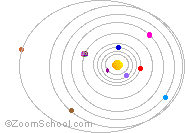The Planets (plus the Dwarf
Planet Pluto)
 Our solar system consists of the sun, eight planets, moons, dwarf planets (or
plutoids), an asteroid belt, comets, meteors, and others. The sun is the center
of our solar system; the planets, their moons, the asteroids, comets, and other
rocks and gas all orbit the sun.
Our solar system consists of the sun, eight planets, moons, dwarf planets (or
plutoids), an asteroid belt, comets, meteors, and others. The sun is the center
of our solar system; the planets, their moons, the asteroids, comets, and other
rocks and gas all orbit the sun.
The nine planets that orbit the sun are (in order from the sun): Mercury,
Venus, Earth, Mars, Jupiter, Saturn, Uranus, Neptune, and Pluto (a dwarf planet
or plutoid). A belt of asteroids (minor planets made of rock and metal) lies
between Mars and Jupiter. These objects all orbit the sun in roughly circular
orbits that lie in the same plane, except Pluto.
Order of the planets (and Pluto) are the mnemonic: "My Very Excellent
Mother Just Sent Us Nine Pizzas"

The largest planet is Jupiter. It is followed by Saturn, Uranus, Neptune, Earth,
Venus, Mars, Mercury, and finally, tiny Pluto (a dwarf planet). Jupiter is so
big that all the other planets could fit inside it.
The Inner Planets vs. the Outer Planets
The inner planets (orbit closest to the sun) are quite different from the outer
planets.
- The inner planets are: Mercury, Venus, Earth, and Mars. They are
relatively small, composed mostly of rock, and have few or no moons.
- The outer planets include: Jupiter, Saturn, Uranus, Neptune, and Pluto (a
dwarf planet). They are mostly huge, mostly gaseous, ringed, and have many
moons (again, the exception is Pluto, the dwarf planet, which is small,
rocky, and has one large moon plus two tiny ones).
A Day on Each of the Planets
A day is the length of time that it takes a planet to rotate on its axis (360°).
A day on Earth takes almost 24 hours.
The planet with the longest day is Venus; a day on Venus takes 243 Earth days.
(A day on Venus is longer than its year; a year on Venus takes only 224.7 Earth
days).
The planet with the shortest day is Jupiter; a day on Jupiter only takes 9.8
Earth hours!
Another Planet?
A few astronomers think that there might be another planet or companion star
orbiting the Sun far beyond the orbit of Pluto. This distant
planet/companion star may or may not exist.
 Our solar system consists of the sun, eight planets, moons, dwarf planets (or
plutoids), an asteroid belt, comets, meteors, and others. The sun is the center
of our solar system; the planets, their moons, the asteroids, comets, and other
rocks and gas all orbit the sun.
Our solar system consists of the sun, eight planets, moons, dwarf planets (or
plutoids), an asteroid belt, comets, meteors, and others. The sun is the center
of our solar system; the planets, their moons, the asteroids, comets, and other
rocks and gas all orbit the sun.
